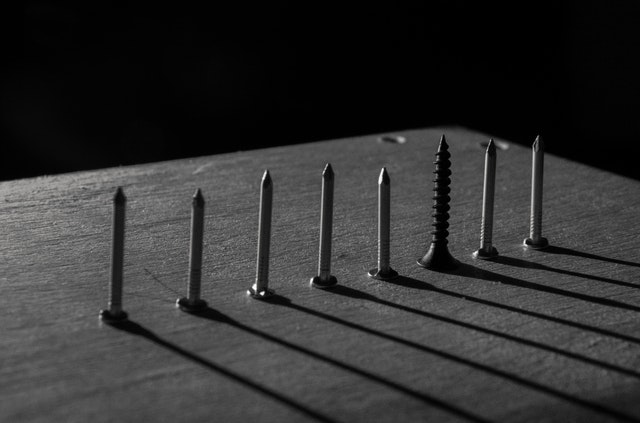A few years ago, I noticed my aunt had a major deformity in the knee. When I asked her about it she said a long time back she’d fallen while putting up Diwali decorations and since then the leg started losing its shape. We took her to the best experts in the city got her MRI scans and discovered that she had osteoarthritis and had lost most of the cartilage in this knee. The doctor recommended immediate surgery and was surprised she wasn’t in throes of pain already. But my aunt was absolutely against surgery and decided not to go for it as she said she was doing perfectly fine as it is. The doctor finally said that she can come for surgery whenever she’s ready. He predicted it won’t be long before the onset of pain. It’s been over two years and despite her “damaged” knee she doesn’t have any pain and functions normally.
I can’t comment on whether she should’ve gone for surgery or perhaps she’s better this way. But it was my first exposure to the fact that chronic pain is not entirely linked to tissue damage! That you could have torn rotator cuffs, labral tears and severe damage to meniscus but yet have no pain whatsoever and could even continue to be active without any complaints.
I’ll admit, it was very difficult to grasp initially. Haven’t we all been bombarded with messages that too much forward and backward bending can wear out the spine, that slouching causes all sorts of havoc to the lower back and that if we don’t brace our core when lifting or bending, we can throw off our backs!
But as it happens, none of the above beliefs are strongly supported by evidence. The new theory around back pain states that a variety of postures are okay for the spine and it’s alright to relax and be comfortable while sitting, standing or bending. That back pain is not caused by weak core, and tightening the abdomens can sometimes be counterproductive resulting in stiffer trunks and spines. All such myths have led us to believe that spine is a highly fragile structure that needs to be protected at all costs by various interventions.
This makes us hypervigilant about posture and fearful of movements like bending or lifting, which maybe entirely unnecessary. Let’s understand why.
(PS: this is going to be a long blog, and if you’re not interested in the theory and research behind, you can scroll down to the section ‘The real cause of back pain’.)
What you didn’t know about back pain
In June 2020, the British Journal of Sports Medicine, released a radical research paper on ‘10 facts every person should know about back pain’. This paper was authored by Peter O’Sullivan and others from Curtin University and it went viral. Their objective was to highlight how unhelpful beliefs about back pain interfere with our recovery and riddle us with persistent back pain instead of curing it. You can see the infographic here, but here’s a quick summary of what they said:
- Back pain is scary, but rarely dangerous
- Ageing, poor posture, slouching, weak core muscles are not a cause of back pain
- Back pain is rarely associated with serious damage, which is why scans rarely show the cause of back pain.
- Pain with exercise doesn’t mean you’re causing harm, it just means muscles are sensitive. And you do not wear out your backs by everyday activities like lifting, twisting, bending
- Pain flare ups don’t mean damage, they could be because of other reasons like stress, lack of sleep etc.
- Injections, surgery, drugs aren’t very effective treatments for back pain.
In July 2021, the University of Curtin researchers challenged another long-standing advice around back pain, which was to keep straight back and squat while lifting. In this study they had each participant perform 100 lifts under observation. Results showed that those with low back pain were in fact more likely to use ‘straight back’ technique while squatting and lifting. And those without back pain tended not to adhere to this advice. Even slouching isn’t associated with lower back pain – in other words, how we sit, stand and bend has very little to do with back pain. And it is safe to be relaxed while operating in our day today life, rather than worrying excessively about ‘incorrect’ posture.
All of these findings seemed to be in stark contrast to what other researchers had been saying these past years. Some top books and methods on back pain, have encouraged maintaining a ‘neutral spine’ while exercising or lifting weights. They’ve also endorsed core bracing technique where you keep your spine and abs rigid when lifting weights. And a lot of fear mongering has been done around certain movements as being ‘risky’ for the back’.
Back pain does not always mean damage.
There have also been quite a few studies where random people who never had any back pain or sciatica were scanned and unknown to them they were found to have significant damage to the spine. In fact, people without any injuries can have severe pain, and those with severe tissue damage may continue to live their lives normally without experiencing any pain, ever. Which reiterates that chronic and persistent pain is not linked to tissue damage.
Here are a few examples of such studies:
- Washington University Medical Center performed MRI scans on 67 people had never had back pain. 28% of them either had a herniated disc or spinal stenosis. (link)
- Hoag Memorial Hospital in California performed MRI exams on 98 people without any back pain. 52% were found to have a disc bulge and 27% a disc protrusion. None of them had any pain or discomfort (link)
- Sports Medicine Center in North Carolina conducted detailed MRI scans on shoulders of 20 elite athletes. 40% had partial to full rotator cuff tears! They were interviewed again 5 years later, but none of them had any symptoms or required any treatment or evaluation for their shoulder. (Link)
- McMaster University, Canada recruited 44 volunteers with no history of knee pain or joint issues. 43 of these 44 people had at least one meniscal abnormality while 60% had abnormalities in 3 of the 4 regions of the knee. (Link)
- In Pennsylvania, 21 professional and 18 collegiate hockey players underwent MRI scans of hip sand pelvis. None of them had reported any symptoms of hip or pelvic pain. 70% of the hockey players had abnormalities in their MRIs and 54% had labral tears. (Link 1 , Link 2)
None of the participants in any of the studies above were in pain or aware that they had any abnormalities. As far as they were concerned, everything was good with them.
Moral of the story is, if you were to point an MRI at any body part, you’re likely to find some damage, which is an inevitable part of being active and growing old. But tissue damage does not always mean you will have pain, and it does not mean you won’t be able to play or move normally.
Context, thought, perceptions, influence how much pain we feel

If I were to scan my spine today and the doctor told me I had some scary disc bulge, I might develop back pain overnight. Because I am conditioned to think that any damage is bad for me, and my brain could simply initiate pain due to my memory of these facts. I may also become more fearful in my yoga practice, become hyper alert about any tiny sensation in my spine and worry that I may do something to become bedridden! This may reduce my activity levels and further contribute to pain. Conversely, I may live many years blissfully unaware of this said bulge and continue to enjoy my yoga practice without any changes. Of course, this is hypothetical, so let’s take a look at this real story.
Once upon a time, a 29-year-old builder accidentally jumped and landed on a 15 cm nail. He was in excruciating pain and had to be sedated while the doctors deftly pulled out the menacing nail out of his foot. But then a miracle happened – when his boot was removed, there was no sign of any injury! It so happened, that the nail had slid between the toes and the foot was wholly intact. Yet, he was in so much pain. Do you think it is strange? Well, it is not. This is normal, that’s how pain works and his pain indeed was real, he didn’t just imagine it.
One of the purposes of pain is to give you time to heal. If there was no pain you’d continue doing what you were resulting in the injury or damage. So, pain is a signal for rest. But that’s not it’s only purpose. It could also be a protective mechanism of the nervous system, maybe the brain decides what you’re doing is not good for you and therefore it triggers pain as a way to stop you. So, even though there’s no actual damage, the brain simply perceived a threat and causes pain before anything even happens.
Your brain can trigger pain for a variety of reasons – it can be to protect you, or when it ‘perceives’ a threat, or it could be influenced by your thoughts, perceptions, context, environment, past experiences or knowledge, emotional state and inputs from the physical body. In the builder’s case above, his brain used context, visual cues (nail sticking out of the boot), horrified look on his coworkers and medical staff and perhaps some other factors to decide that there should be pain. Even though there was no actual tissue damage. And mind you, we have no conscious control over this process. You cannot wish away or think away pain, when it strikes, it is very real.
This is how all the scary sounding conditions, too much information and fear mongering by other people or media can influence our experience of pain. And also why new research is saying that neither scans nor surgeries or drugs really help with chronic lower back pain anyway. Since the real cause of pain could be absolutely anything!
Let’s explore this a little more.
The power of words in influencing back pain
“Call something fracture and people will take longer to heal. Call it crack in the bone and people won’t even think you need a cast.” head on The Better Movement Podcast
People are likely to take longer to heal if doctors tell them they have a scary sounding condition. If the problem is less sinister, people are more hopeful and feel like they recover well.
In a study in Denmark, researchers divided a bunch of people into 3 groups to do few rounds of the wall squat exercise. However, before starting, Group 1 was given positive information about the exercise and how it reduces pain. Group 2 was given neutral information mostly stating how to do the exercise. And Group 3 was given negative information about how exercise can induce pain. After the briefing everyone went ahead and finished their exercise routine. And the results were not surprising – those with positive information before their workout saw significant improvements in their pain threshold. While those with negative feedback saw a decline and had greater sensitivity to pain.
Everyone did the same exercise, for same duration, but the last group experienced more pain and discomfort. And that is the power of words.
Whether you’re someone suffering from back pain, a fitness coach, or a yoga teacher, it is useful food for thought and I would encourage you to introspect and reframe your attitude towards pain or how you engage and communicate with students.
The real cause of back pain
Most injuries heal within three months and if pain persists beyond that it is likely due to reasons other than tissue damage. When it comes to chronic back pain, researchers have identified some common reasons as follows:
- Smoking – is a very strong predictor of back pain, perhaps the strongest reason of all. There’s a solid correlation between the number of cigarettes you smoke in a day and the prevalence of back pain.
- Lack of sleep – If you’re not getting enough sleep, you’re more likely to get injured and also likely to be in more pain. Because sleep deprivation makes the brain more sensitive to pain signals. As per a research more than 50% of people suffering from insomnia, report back pain.
- Doing too much too soon – Physically demanding work that you’re not accustomed to pushing the body beyond capacity, can result in pain. For instance, if you’ve been living a sedentary life but then suddenly run a marathon tomorrow morning or attempt 40 Chaturangas in a random Power Yoga class, you may end up with pain. Therefore, it is important to gradually build tolerance. Additionally, exercising or repeatedly lifting when tired and fatigued or in poor mental health are also linked to higher back pain.
- Sedentary life – If you’re largely inactive, you’re more likely to get back pain. So, stay active, in whichever ways you like. Could be Hatha, Power or Vinyasa Yoga, or any other form of activity.
- Being overweight – Obesity is linked to back pain and some studies have found that as BMI increases, back pain events may also increase. However, some research has also found that neither age or weight is linked to back pain, but being obese can delay recovery, prolonging the period of pain. In general obesity is linked to higher complaints of chronic pain including headaches, abdominal pain, and lower back pain.
- Fear – those patients who were more fearful of forward bending also had more pain and disability, with poor treatment outcomes. People with back pain who were afraid of movement also had stiffer trunks.
- Catastrophizing – exaggerated negative opinion of pain and rumination which results in greater pain intensity and disability
- Stress – the degree stress someone has is very strongly associated with lower back pain. In fact, severe stress can cause ~3-fold increase in back pain.
- Poor Sleeping habits – Sleeping on the desk, staying up late etc are associated with both lower back pain and neck pain.
- Technology – spending long time on computer, mobile phone, TV was associated with neck and back pain.
- Depression / anxiety / fatigue / low-self efficacy – Depression in particular is a strong predictor of intense and disabling neck or lower back pain. And having greater confidence in one’s abilities to heal helps in recovery.
- Anger – Suppression and over-expression of anger, both are associated with lower back pain.
- Low job satisfaction / hopelessness – Greater job satisfaction protects against back pain becoming chronic. Conversely, job dissatisfaction means higher risk of persistent back pain.
This list is not exhaustive, there could be other reasons for back pain. Sitting too much, long hours of driving, and forward head posture also have some weak evidence linking them to back pain.
But I hope it gives you enough of an idea that back pain is not just about the body, it is also as much about the mind. Which is why treatment of back pain cannot be just exercise or stretching – it needs to include stress management activities as well.
How can Yoga help?
Spine is of significant importance in Yoga, not just physically but also spiritually. It is the house of our central nervous system and is interpreted in Yoga through the Pranic Nadi System. Therefore when people with history of back pain come to Yoga, and ask me which pose to do and what will help them more to avoid an adverse event, this is what I say:
- Add a variety of postures
Don’t just keep repeated the same ones. Diverse movement is one of the best things you can do for backpain.
- Move in all different directions
Explore forward bends, back bends, twisting, side bending as per your capacity
- Go slow
Gradually build capacity for them, don’t be in a rush. Doing too much too soon or attempting things you’re not accustomed to is a leading cause of back pain
- Avoid perfectionism and pursuit of ‘one correct alignment’
When it comes to posture, there’s no one size fits all. We’re all unique, and our bodies have developed with different types of mechanical stresses, so we may all hold ourselves up differently. This is also true for your yoga practice, there’s no one ideal alignment for a posture. It will vary for different people and what feels good to you, may be different from what feels good to someone else.
- Add load
You can do so by using weights or resistance bands in your yoga practice. Or you can separately make time for strength training 2-3 times a week – it is highly protective against injuries and useful for yoga practitioners.
- Practice Pranayama and Meditation
They are excellent for stress management. They help calm down the nervous system, reduce our sensitivity and have a strong impact on pain.
It is important that you get clearance from your doctor or therapist for starting your yoga practice. Yoga teachers or fitness coaches cannot diagnose or treat pain.
In a nutshell, instead of focusing on one or two postures or stretches, it is important to diversify your practice and explore various forms of movement. You can even experience the same posture in multiple different ways by using yoga props. Which is why so many people with chronic aches and pains benefit from Iyengar Yoga.
So, bring more variability in to your practice, try each pose in multiple different ways, with different intentions for greater mind-body awareness. Adding variety, being more inclusive, and avoiding misguided perfectionism are some ways you can make your Asana practice more wholesome and effective.
Summary
There are many conflicting views on how to treat back pain effectively. Which is why there’s no one treatment today that works for all – each doctor, therapist, patient has had their own unique experience and theories around what works and what doesn’t. This happens because we tend to think of chronic pain as a result of some kind of damage in the body. So, the usual treatments we seek are some stretches, strengthening exercises, or rehab programs to help us ‘fix’ that damage. Whereas, as you’ve hopefully grasped by now, chronic pain, rarely has anything to do with bodily damage.
Rather pain is very strongly influenced by genes, your mind, memories, thoughts, emotions and your social and cultural environment. For instance, you’re likely to feel more ‘unwell’ if you have people around to take care of you, compared to when you’re alone. You’re more likely to ‘heal’ if you like your doctor or have faith in the person treating you or the treatment being given to you.
I hope this new perspective also gives you renewed hope if you’re suffering from chronic back pain. This article has been written purely for informational purposes and is not to be substituted for sound medical advice by experts. However, if you’ve struggled with back pain for a while without much avail, here are some helpful resources to help you find more support in your healing journey.
- Infographic on 10 facts about back pain
- Patient stories behind the above paper
- Podcast by authors of above research paper
- Todd Hargrove’s book A guide to better movement







